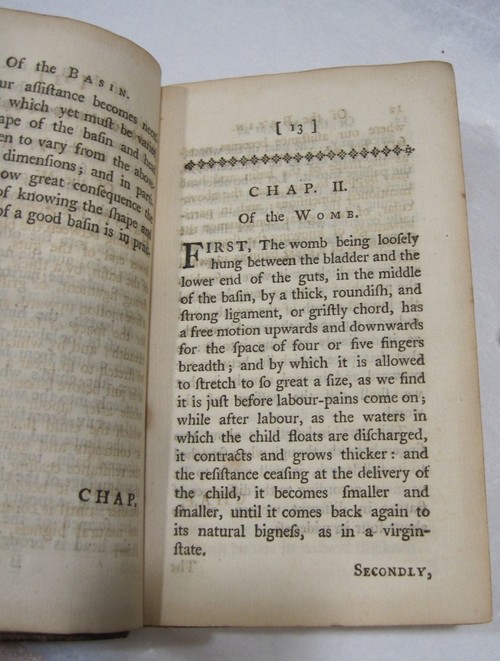Excerpts
“It is acknowledged that the books on the art of delivery are already increased to a considerable number, and that some of them are well-written, wherein it appears that it has been much improved of late years; yet, as the following sheets are written on a plan of more extensive use than any of them, we presume that this may serve as a sufficient apology for the present small publication [...].
Women for some time past have been regularly instructed in this art by physicians and surgeons in many parts of Great-Britain; and being lately engaged in the same way, we soon found it needful to bring the latest and best practice into a small compass, and make it intelligible to female pupils.”
“The conception in the womb in the first month, resembling as it were a young frog, there appearing at that time a large head with a small trunk, etc, before all the parts of the human body are distinctly formed, is called an embryo.
When a woman has gone three or four months with child, it being then about the bigness of a large goose egg and its parts all formed, it is called a foetus; about which time nearly a quarter of the neck of the womb is stretched equal to its bottom, and the child, though complete as to parts, yet is not as to degree, ‘till about four or five months more growth.
The womb from conception, has a softish substance, of a red flesh-like colour fixed to its inside, called the womb-cake, daily growing greater and greater, ‘till about the ninth month, when it arrives at its greatest size; being then about six fingers breadth wide, and about one finger’s breadth thick in the middle, but thicker and thinner towards its edge.
It is of round figure, like an oatcake or bannock, and composed of a very great number of small blood vessels, meeting together in one large vessel or vein, or rather three inclosed in one coat or case; and it called the navel-string, which is commonly four or five hands breadth in length, though sometimes not above two or three; yet at other times it happens to be eight or ten hands breadth long.”
““A quick natural birth is that in which the crown of the head presents, and the woman is soon delivered by the true pains and ordinary assistance; whereas in the lingering, it takes up several, perhaps many hours.””
““In order to deliver unnatural births, there is, as aforesaid, an absolute necessity for the assistance of instruments [...] 1. A blunt-pointed extractor, called the forceps, contrived so as to draw out the child alive with the help of our hands. 2. a sharp=pointed extractor, called the crotchets, together with a pair of long small scissors, with stops in the middle of their blades, for drawing the child dead from the womb. 3. A double blunt hook for assisting in delivering the child, whether it be alive or dead in the womb.””
This book is one of the earliest dated volumes in the rare book collection at the George Marshall Medical Museum. Dated 1765, it contains chapters on the female anatomy and of natural and unnatural births.
Traditionally, midwives delivered all babies. Like barber-surgeons, they had no formal education, but instead gained experience by working with experienced practitioners. They worked alone, travelling to each expectant mother's home, and stopping in the house after the birth. Midwives had a legal responsibility to witness births. As women, they were only allowed to deliver so-called natural births, and if there was any kind of unusual activity they would have to call for a doctor or surgeon to assist.
After thousands of years of women-only births, during the 1700s male midwives began to appear, selling themselves as a safer option for ladies in childbirth. These men were medical graduates with anatomical training who used forceps for difficult births. Upper- and middle-class women switched to male midwives until the 1800s, where successful efforts were made to improve training for females (improvement in public health policies also helped).
This book, dated 1765 contains chapters on the female anatomy and of natural and unnatural births and hoped to provide "Full and plain directions for the management and delivery of child-bearing women in the different cases, and the cure of the several diseases incident to them and newborn children, in the safest manner, and according to the best improvements."
